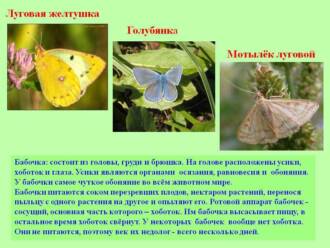Many are interested in the benefits of butterflies and do not understand why they are needed in nature. Butterflies are fluttering flowers. Butterflies live from several hours to several weeks. And only those who have overwintered can live for several months, such as, for example, buckthorn, which lives 10 months.

Despite their short life, butterflies in almost all nations symbolize immortality. The Aztecs associated the daytime butterfly with the sun and called it “swaying fire”, and the nighttime (“obsidian”) butterfly with the spirit of the stars and considered it a symbol of the souls of women who died during childbirth. In connection with these representations, artists often depicted butterflies on the hand of the infant Christ.
Charles Darwin in his book "Journey on the Beagle" described a butterfly that can ... walk. This is Papilio Feronia. Her taste buds are located on her legs, with which she tastes the plant. She even runs on them to her rescue, although this is more an exception than a rule.
Butterflies have excellent eyesight.. They also have an ultraviolet spectrum. One of their eyes consists of 17,000 facets - polyhedral crystals. No one has more perfect eyes than theirs, and even dragonflies.
Butterflies from pupae usually appear in the evening and after a few hours, spreading their wings, they go right at night on their first flight.
It is noted that caterpillars swallowtail they feed on umbrella plants, Maak's tail-bearer - on the leaves of a velvet tree, iris caterpillars feed on the juice of affected plants, and the most fastidious of them - only rotten bananas, thistles - on prickly hard leaves of the plant of the same name.
large peacock eye (a symbol of the unique Far Eastern nature) - one of the most famous and beautiful, most often found (even in city parks) butterflies - feeds only on stinging nettles. 2 antennae extend from the tiny head of this moth. These devices of theirs can be attributed to the most sensitive devices on earth that capture the smell, incl. the smell of a female, - about 11 km.
Very often Russian names hawks correspond to the plants on which their caterpillars feed: euphorbia (on euphorbia), poplar, oleander, pine (on pine, less often - spruce), oak. There are species among them whose caterpillars develop on apple, pear, plum, potato, eggplant and thereby harm crops.
From early morning, butterflies actively “work”, pollinating plants, and all afternoon until late at night they breed.

The benefits of butterflies for nature
In the sphere of plant pollination, these life-affirming creatures of nature are second in importance to bees, and sometimes the first. They give life to plants, but do not forget about the continuation of their kind. For example, the yucca moth living in the desert is the only pollinator of the flowers of the cactus of the same name. Butterfly transfers pollen from flower to flower and immediately lays 3 eggs. Subsequently, part of the seeds developed from pollen "continues the genus" of the yucca cactus, and part goes to feed the caterpillars of the butterfly itself.
Some tropical plants (a number of species of the orchid family, bindweed, etc.) are also pollinated exclusively by butterflies. And some caterpillars feed on harmful insects. For example, the caterpillar predator of the worm-eater butterfly feeds on olive false scales, helping people in the fight against garden pests.
Useful include silkworm butterfly (oriental and oak), used in the national economy. But there are also harmful ones among them: winter scoop, nun, gypsy moth, golden tail, codling moth, furniture moth, pestryanka (poisonous and dangerous for birds) and etc.
The study of flights and migration of butterflies is of great importance for preventive measures to combat pests in agriculture.
Read more:





